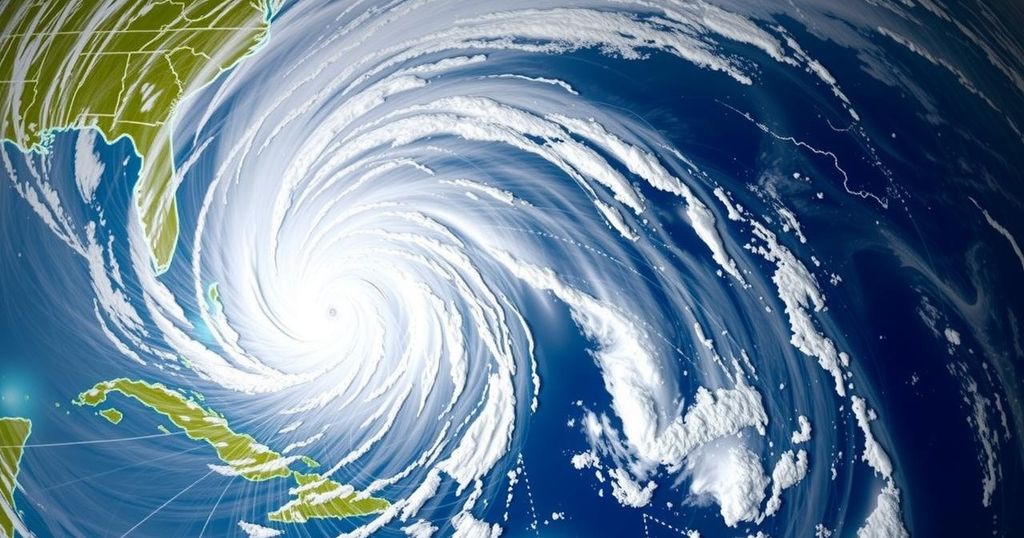Recent Hurricanes as Indicators of Increasing Weather Extremes and Agricultural Impact

Recent hurricanes are indicative of increasing weather extremes due to climate change, with rising temperatures fueling storm intensity. Experts caution that the effects of climate change could bring about more severe rainfall and drought, challenging agricultural practices. Farmers recognize these shifts, reinforcing the need for adaptation in the face of changing climate patterns.
Recent hurricanes have become emblematic of potentially increasing weather extremes fueled by rising global temperatures, with significant implications for agriculture. Chris Forest, a professor of climate dynamics at Penn State, emphasizes the importance of ocean temperature trends in forecasting extreme weather. The increasing heat and humidity associated with climate change are believed to energize hurricanes, as demonstrated by the impact of storms like Helene and Milton in the southeastern United States this year. While hurricanes have not yet reached Category 6 intensity, there are discussions among scientists regarding the necessity of updating the classification system due to observed intensities surpassing traditional metrics.
Forest notes that ongoing warming trends in tropical temperatures will continue to increase hurricane energy, leading to more intense storms. However, this does not simplify the task of weather prediction, as factors such as the El Niño phenomenon significantly influence global weather patterns, from the Gulf of Mexico to Africa. Despite the rise in hurricane activity, forecasting remains challenging due to the limited data sampled from the relatively few storms each season. The long-term trend suggests that warmer waters are likely to result in storms with severe impacts upon landfall.
Recent storms like Hurricane Helene illustrate these effects, with its torrential rains causing flooding far inland. Forest points out that, “The warmer the air is, the more water can be carried by the air,” linking increased precipitation levels even in non-hurricane storms to climate change. Looking ahead, both heavy rainfall and drought conditions are projected to pose significant challenges to farmers, potentially surpassing the impact of hurricanes.
Farmers recognize this shifting climate landscape; a survey revealed that a majority of large-scale row crop producers in Maryland view climate change as a reality that necessitates adaptation. As stated by one farmer, “Drought is longer, heat is hotter, and when storms come, they are heavier and more severe.” The year 2024 is expected to break records for warmth, fueled by an extended series of elevated temperatures. The World Meteorological Organization has indicated that the decade from 2015 to 2024 was the warmest on record, with extreme weather resulting in significant economic and community disruptions.
Moreover, the ongoing challenges facing crop producers, ranging from altered precipitation patterns to the encroachment of new pathogens, underscore the urgency of mitigating climate change. Andrew Feldman, a NASA hydrologist, highlights the implications of varying rainfall patterns on agricultural productivity, asserting that daily variability in water availability affects agriculture. Adaptation strategies will be essential as the climate continues to evolve.
The article addresses the implications of climate change on hurricane intensity and agricultural practices. It underscores the relationship between rising global temperatures and the increasing frequency and severity of storms, particularly hurricanes. Insights from experts in climate dynamics and meteorology present a multifaceted view of how these changes in climatic conditions affect not only weather predictions but also the agricultural industry’s adaptability to such shifts. The discussion incorporates findings from recent surveys conducted among farmers, indicating a collective recognition of climate challenges.
In summary, recent hurricanes signify a trend towards more extreme weather events linked to climate change, presenting notable challenges for farmers and agricultural practices. The insights shared by experts indicate that rising temperatures will likely intensify storms and alter rainfall patterns, necessitating urgent adaptation measures within the agricultural sector. The acknowledgment of climate change as a pressing reality among farmers reinforces the need for proactive strategies to mitigate its impacts on crop production.
Original Source: www.lancasterfarming.com







